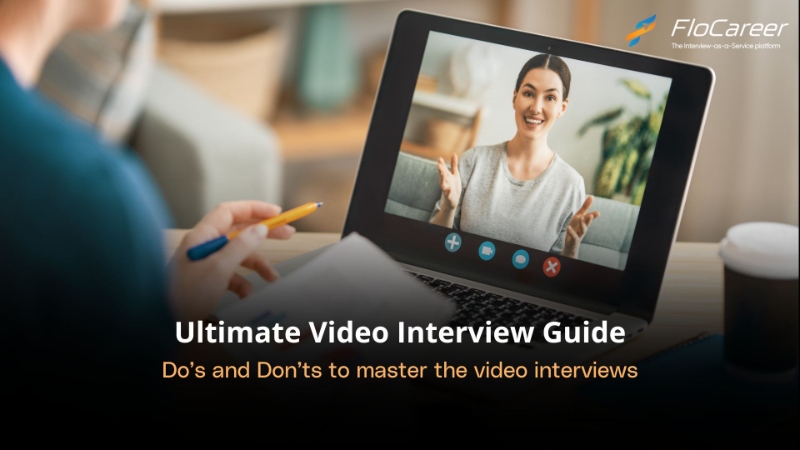Video Interview Tips: Do’s and Don’ts to master the interviews
The evolution of recruitment practices has brought video interviews to the forefront, offering a flexible and efficient way to connect candidates with potential employers. Navigating the nuances of virtual interviews requires a strategic understanding of the dos and don'ts, essential for both candidates and interviewers. This in-depth guide explores the critical points that can make or break a video interview experience, emphasizing their importance from both perspectives.

The Dos of Video Interviews:
Tech Preparedness:
For Candidates: Adequate tech preparation is not just a formality; it's the foundation of a smooth interview. Ensure your internet connection is stable, your camera offers a clear image, and your microphone transmits your voice crisply. Technical glitches can disrupt the flow and leave a less-than-ideal impression.
For Interviewers: Communicate any specific technical requirements well in advance. A seamless interview experience starts with ensuring that both parties are on the same page technologically.
Optimal Environment:
For Candidates: Your chosen interview setting speaks volumes about your professionalism. A quiet, well-lit space with minimal distractions showcases your commitment to the opportunity. Background noise or poor lighting can detract from your message and affect the overall impression.
For Interviewers: A professional and distraction-free environment on your end sets the tone for the interview. Background visuals matter, and a cluttered or noisy backdrop can impact the candidate's perception.
Professional Attire:
For Candidates: The importance of dressing professionally for a video interview cannot be overstated. Your attire reflects your seriousness about the position. Even in a remote setting, the right outfit contributes to a positive first impression.
For Interviewers: Conveying the expectation of a professional dress code sets the tone for a formal and respectful interaction. It reinforces the seriousness of the hiring process.
Effective Communication:
For Candidates: Maintaining eye contact with the camera creates a sense of connection with the interviewer. It's a subtle yet powerful way to demonstrate engagement and interest.
For Interviewers: Creating a conversational atmosphere is crucial. A rigid or overly formal approach can make candidates feel uncomfortable, hindering the flow of communication.
Preparation for Questions:
For Candidates: Beyond researching common interview questions, practice delivering your responses. This not only enhances your confidence but also ensures that your answers are concise and relevant.
For Interviewers: Clearly outlining the format and types of questions candidates can expect helps in setting expectations. It also ensures a fair and consistent evaluation process.
Check Your Background:
For Candidates: Ensure that your background is tidy and professional. A cluttered or messy backdrop can distract interviewers and create a negative impression.
For Interviewers: Encourage candidates to choose a well-organized setting for the interview. A clean and professional background reflects positively on their attention to detail.
Maintain Good Posture:
For Candidates: Sit up straight and maintain good posture throughout the interview. It exudes confidence and attentiveness.
For Interviewers: Modeling good posture sets a positive example for candidates. It fosters a sense of professionalism and engagement.
Test Your Equipment Beforehand:
For Candidates: Conduct a thorough test of your camera, microphone, and internet connection well in advance. This proactive approach prevents last-minute technical glitches.
For Interviewers: Emphasize the importance of a tech check to candidates. Providing clear instructions on the equipment requirements ensures a smooth start to the interview.
Use Professional Language:
For Candidates: Speak clearly and professionally, avoiding casual language or slang. Effective verbal communication is key to leaving a strong impression.
For Interviewers: Demonstrate professionalism through your language. Clearly articulate questions and provide concise, informative responses to candidates.
Engage with Visual Aids Thoughtfully:
For Candidates: If using visual aids, such as a portfolio or slides, ensure they are well-prepared and relevant to the discussion. Smooth transitions and clear visuals enhance your presentation.
For Interviewers: Encourage candidates to share relevant visual aids if applicable to the role. Assess how well they integrate these aids into the conversation.
The Don'ts of Video Interviews:
Technical Surprises:
For Candidates: Waiting until the last minute to check your equipment is a risky move. Technical issues can lead to stress and frustration, impacting your performance.
For Interviewers: Overlooking the importance of a pre-interview tech check can lead to disruptions during the interview, affecting the overall experience.
Casual Attire:
For Candidates: Dressing too casually, even for a remote interview, sends the wrong message. It's essential to align your attire with the formality of the position you're applying for.
For Interviewers: Neglecting to communicate expectations regarding attire can result in candidates being unsure about the level of formality expected.
Ignoring Non-Verbal Cues:
For Candidates: Non-verbal cues are a powerful aspect of virtual presence. Ignoring their impact can hinder effective communication and connection with the interviewer.
For Interviewers: Disregarding the significance of maintaining positive body language can affect the candidate's perception of the interview and the company.
Ignoring Lighting Considerations:
For Candidates: Poor lighting can obscure your facial expressions and affect the clarity of your video. Avoid sitting with a window behind you or in overly dim lighting.
For Interviewers: Overlooking the impact of lighting can make it challenging to assess candidates' non-verbal cues. Remind candidates to choose well-lit spaces.
Overloading on Background Distractions:
For Candidates: Steer clear of backgrounds with excessive movement or distractions. A busy backdrop can divert attention away from your responses.
For Interviewers: When conducting interviews, choose a quiet location to minimize background distractions. This ensures a focused and productive conversation.
Multi-Tasking During the Interview:
For Candidates: Resist the urge to check emails or engage in unrelated tasks during the interview. It demonstrates a lack of focus and can be perceived as disinterest.
For Interviewers: Similarly, avoid multitasking during interviews. Give candidates your full attention to accurately evaluate their responses and engagement.
Neglecting to Establish a Personal Connection:
For Candidates: While maintaining professionalism, aim to build a personal connection with the interviewer. Failing to do so might result in a lack of rapport.
For Interviewers: Strive to create a welcoming environment that allows candidates to showcase not just their skills but their personality. Ignoring this aspect may result in a less nuanced evaluation.
Each dos and don'ts point plays a pivotal role in shaping the video interview experience for both candidates and interviewers. From the foundational aspects of tech preparedness to the subtleties of non-verbal communication, every detail contributes to the overall success of the virtual interview. As you embark on the journey of remote hiring, leverage the insights provided here to create a seamless and positive experience for everyone involved. At FloCareer, we understand the nuances of modern recruitment. Explore our suite of tools designed to enhance every facet of the hiring process, ensuring a tech-driven, inclusive, and effective recruitment journey. Embrace the future of interviews with FloCareer, where innovation meets excellence.
Learn more about Interview-as-a-Service in our latest blog


